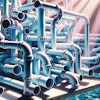Webster's Dictionary defines art as the human ability to make things; creativity of man as distinguished from the world of nature. And while water is one of nature's greatest gifts, the ability to meld it into our daily world by manipulating it in a way that puts it wherever and whenever you'd like is an art in itself.
The Art Of Water

Chafey's poetic approach toward water has helped him create beautiful features and fountains throughout Arizona - some included in high-end pool projects, others freestanding.
"We have taken many landscapes and courtyards that people walked past for years without even the slightest hesitation or observation, and created the most basic of water features," says Chafey. "We created not only a visual trap, but a destination. An entry courtyard that was never used becomes the place to read the morning newspaper and drink coffee."
The destinations Chafey has added to his portfolio stem from a variety of inspirations, none of which he attributes to a single architect, source or style. So while his creative influence remain all of the beauty in the world around him, he still recognizes his duty as a designer to provide clients with his signature style.
What's Vogue?
Chafey cites two important rules for designing projects: meet client needs and make sure the design is in harmony with its surroundings.
"We really try to make sure our overall design complements the entire project. On some projects, the feature is the focal point and can be the defining style, but at the same time, it must be in the correct scale, and the materials have to coordinate with the rest of the project's unique style."
Red Rock likes to keep things natural and earthy looking, says Chafey, so it uses a lot of stone, marble, brick and concrete as the main material and then plays up the color to add impact.
"Small amounts of bold colors can often make huge impacts on the features, making them unique," he says.
Chafey notes the majority of Red Rock's work tends to have a more contemporary feel, "it really comes down to our designers and what they feel the flavor of the day is."
Such "flavors" include pondless projects where the focus is on moving water rather than a single body of water. Chafey says nearly 75 percent of the water features Red Rock completes have nothing to do with a pool. The older demographic looking for water features has discretionary income, and they are more interested in upping the ante of their landscaping than building a pool, he adds.
"I think we design our pools and water features to be more artistic than functional," says Chafey. "We do many pools just for swimming, but now in a lot of our projects we try to make it so they are used 365 days a year, because they are part of the beauty of the backyard, not just a hole in the ground filled with water."
Chafey adheres to specific building techniques when working on a project. "Our signature style would be the parts you do not see, the workings of the feature that make it remain enjoyable to the customer."
Technical Standards
"I think the most important rule to follow is to make sure it is low, low, low maintenance," says Chafey. "A great idea and concept quickly loses its appeal when it requires hours of work to keep it in operation. We try to make sure everything we create not only looks great, but also functions economically, as well as being very user friendly and needing minimal maintenance."
The biggest trend Chafey pushes on his clients, he says, is environmentally friendly systems that save power and make the entire operation more efficient. He incorporates variable-speed pumps into the majority of his projects since many features run 24 hours a day and makes a concerted effort to design the circulation systems properly so they run as efficiently as possible.
Chafey admits to the challenge of selling the higher cost of a properly designed project, but reiterates to clients that the real payoff is in the enjoyment of the finished product.
While Chafey incorporates what he calls "better products and pump systems" into projects where more money is to be invested in the interest of less maintenance, he says he's finding that a lot of the homeowners of the smaller projects are OK with less automation and more maintenance.
He admits, though, to liking the more expensive projects, simply because "it's less of a hassle in the long run," he says. "You've got a customer that lives in a $200,000 house, and you have an $80,000 water feature in their backyard. So sometimes, not always, we are seeing the trend where people are spending more or as much as they do on their house in their backyard." No matter the client's financial ability, Red Rock is capable of completing a lot of projects that still maintain their unique character and fall in the $5,000 to $8,000 range.
Like any true artist, Chafey ultimately has one goal in mind. "The hope is to create a visually stunning feature that takes your breath away every time you see it, but also to create one that seems to capture you, becoming a destination all its own."
Comments or thoughts on this article? Please e-mail [email protected].







































